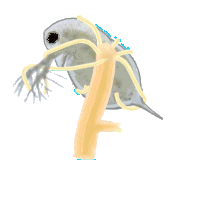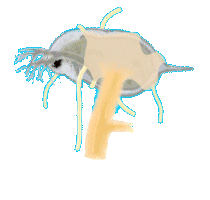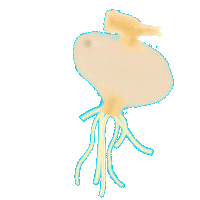 |
 |
 |
 |
 |
 |
 |
 |
 |
| Drawn
to scale with one another, these images tell everything but the time. "Before"
was 5:00 p.m. of the day after I'd brought the hydra home, examined it,
and put it in a jar of water well populated by water fleas. "After" was
midnight, only seven hours later. The hydra caught the daphnid at 5:20.
By 5:25 the hydra's mouth had expanded noticeably, covering about half
of one side of the prey's carapace. By 5:40 the hydra's mouth had closed,
and the hydra's body sagged downward with the weight of its meal. When
I checked at 10 o'clock, the hydra's position and appearance had not changed.
At midnight, I found a noticeably larger hydra; its bud and the bud's tentacles
had grown, too.
The brown hydra, H. oligactis, is the largest of the common hydrozoans. It is said that this species sometimes causes problems at fish hatcheries by eating the small fry. You'd better believe it. |
Comments to the author Rosemarie Arbur welcome.
Please report
any Web problems or offer general comments to the
Micscape
Editor,
via the contact
on current Micscape Index.
Micscape is
the on-line monthly magazine of the Microscopy UK web
site at Microscopy-UK
WIDTH=1